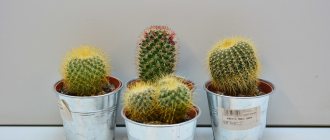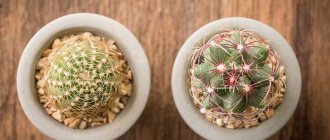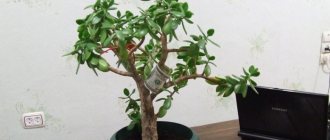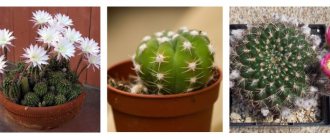Signs of cactus damage
In succulents, diseases occur in a latent form, so it is not always possible to immediately determine the disease. Affected plants stop developing for a long time or drop their buds. To protect home crops from problems, you need to know the common symptoms.
Cactus rotting
If rotting begins from underground parts, then the root system is completely destroyed. Healthy organs are white-gray in color and do not crumble or crumble in your hands. Red or brown areas appear on the thread tissues, which destroy the plant. The culture stops growing and does not absorb water well. The soil in the pot does not dry out, becomes moldy and has a musty smell.
If the cactus has rotted from the inside, then the fleshy trunk becomes soft to the touch. The patient loses stability in the pot, falls out of the ground, or bends in half. The plant gradually changes color to yellow or gray. External tissue destruction is accompanied by:
- loss of shine on the surface;
- the appearance of spots;
- falling of thorns.
Drying cactus
The plant quickly decreases in size, wrinkles and loses color. Affected specimens do not hold well in the pot and may fall out of the container. The mummified cactus is covered with a thick skin that bursts when cut. A dried flower cannot be revived.
Preventive measures
To avoid questions about how to save a cactus, it is advisable not to initially expose it to risks. Firstly, you should ensure the most comfortable climate - dry, warm, without sudden temperature changes. Secondly, the root system must be ventilated due to the loose structure of the soil, the presence of heterogeneous mineral additives (stones, sand) and an air-permeable drainage layer. In addition, it is important:
- Before purchasing, carefully check plants for the absence of diseases and pests;
- replant new and grown cacti into the correct substrate;
- disinfect the soil and pots by calcining, freezing or washing with a saturated solution of potassium permanganate to destroy bacteria and fungi.
opryskivanie-kaktusov-iz-pulverizatora-928×1024.jpeg
Causes and treatment of rot in cacti
Favorable conditions for succulents are plenty of sunlight and warmth. In prolonged cloudy weather and temperatures below +17 C, the plant does not absorb moisture well. In wet soil, fungi and viruses actively develop, which quickly destroy indoor flowers.
Late blight or rotten leg
If the cactus is rotten from below, then this is a sign of a contagious disease. Pathogens live in the soil, in new plants and seeds. A patient who broke at the base of the trunk cannot be resuscitated. Less advanced cases are treated by cutting out the affected tissue and treating with fungicides.
Helminthosporiosis
The fungal disease comes with planting material from natural conditions. Affected plants dry out and bend sideways within a few days. If the symptoms are not noticed in time, the flowers die.
Diseased tissues are cut off and treated with antibacterial agents.
Rhizoctoniosis, or wet rot
The disease prefers to develop on cuttings and seedlings. The fungus begins to capture healthy parts from the base of the stem and gradually moves to the tops. The disease can be recognized by watery marks on the skin that darken and die.
Fusarium
The first stages of the disease pass unnoticed by the grower. The fungus affects the root system and spreads through the vessels. The cactus takes on a reddish or purple hue. If you cut the stem, you can see a dark ring on the tissue. The plant dries out at the base, breaks off and falls out of the pot.
Black rot
Fungus is a common reason why a cactus rots and dies. On an infected specimen, weeping spots and drips appear, and the spines fall off. The pathogen is activated by poor lighting, high humidity and injuries to the stem.
Fomoz, or dry rot
If the plant slowly deflates from the inside, the culprit is Phoma. Dry rot on a cactus cannot be treated; it quickly moves to healthy flowers. To prevent the occurrence, preventive treatments with a fungicide are needed.
Dry rot
It is quite difficult to identify this disease. usually discovered when the cactus is in its “death” stage.
What to look for during inspection?
When infected by Phoma rostrupin fungi, the plant turns pale and begins to dry out. Most often this goes unnoticed. Then dry crusts covered with cracks appear on the body of the cactus, and when pressed, your finger falls into the trunk. If the stem is cut, the cactus turns out to be empty, dried out inside.
Prerequisites for the disease
Introduction of the Phoma pathogen through wounds on the trunk of a cactus. When replanting or transporting a plant, you can accidentally damage the integrity of its body. In such cases, the fungus penetrates through the damaged areas, and the cactus becomes infected.- Violation of wintering conditions. If wintering is not organized correctly, the cactus’s resistance to infectious diseases decreases.
- Excessive watering. Excess moisture causes rotting of the root system, which weakens the plant's resistance to infectious diseases.
- Vaccination with a sick cactus. Only healthy plants should be grafted.
- Replanting into soil previously used for another plant. If a cactus suffering from dry rot previously grew in the soil, such a substrate should be destroyed and under no circumstances used for other plantings.
How to resuscitate when a flower is completely damaged?
If rotting has spread throughout all tissues, then the cactus is difficult to save. The plant is removed from the pot, the dead parts are removed with a clean knife, and treated with Fundazol or Topaz. If the crown is intact, then the stem is cut in the form of a blunt pencil. The area is powdered with activated carbon and left to dry for a week in a place without sun. After 7 days, the patient is fixed with sticks over a pot of sand.
Do not water for a month, only spray.
What are the chances of rehabilitation?
The more the cactus is damaged, the less opportunity for regeneration. If the disease has affected 80% of the tissue (especially on top), then treatment will not help. Large specimens with a fleshy stem can be put on intensive care, but small ones and seedlings often die.
Rotting of cacti is a dangerous transformation that is caused by care errors, diseases or parasites. To prevent a problem from occurring, you need to follow the rules of agricultural technology. The amount of watering for succulents depends on the time of year and temperature. If the plant is sick, then resuscitation must begin.
How to care?
Cactus is a plant that does not require special attention. However, certain rules must be followed to avoid infection with rot.
- This plant requires a lot of light; the cactus should be placed on or near a windowsill.
- The cactus should be watered as needed, adhering to the principle “the warmer the room, the more abundant the watering,” but not more than once every 2 days.
- During the dormant period, water the cactus once every 1.5-2 weeks, monitor the temperature and lighting in the room.
Sampling
Natural change in cactus tissue at the bottom of the stem. The rough yellowish layer improves the mechanical stability of the massive plant. The defect is hidden under the soil by adding fresh soil mixture.
Kidney abscission
Leaf-like cacti shed buds when there is a lack of water, excess nitrogen and dry air. If the plant has set flowers, then the position of the pot cannot be changed. Early exit from wintering and abundant irrigation provokes the problem.
Burns
After winter, you should not place cacti in very bright sun. The crop becomes unaccustomed to ultraviolet radiation, so intense radiation causes burns. Pale yellow marks on fabrics remain forever.
Chlorosis
The destruction of chlorophyll in plant stems appears in the form of light spots. The problem occurs when there is a deficiency of magnesium and iron in the substrate. To prevent spread, you need to feed with complex fertilizer.
No growth
Cacti develop during spring and summer. Lack of irrigation, depleted soil and nutrient deficiency will make awakening impossible. If the culture has not started to grow, then care needs to be reconsidered.
The plant begins to get very thick and burst: what to do?
When growing houseplants, you cannot go to extremes. Novice gardeners mistakenly believe that if a cactus is overfed, it will feel better. The results of such experiments are:
- the green pet literally swells;
- the skin begins to burst in many places.
Why does this situation arise?
The causes of “obesity” are frequent and abundant fertilizing with fertilizers that are not suitable for this species, planting in too fertile soil, and abundant and frequent watering. The explanation may be the high nitrogen content in fertilizing.
What to do in this situation? Experts recommend replanting into lighter, looser soil and reducing watering of cacti to the required level. The soil should dry out between each portion of moisture. It is necessary to choose not universal fertilizers, but those specifically designed for cactus. It is better to care for indoor plants according to a predetermined schedule. In this case, you certainly won’t forget anything.
The appearance of spots and mosaics
The cactus turns yellow, begins to become covered with spots, and also turns red due to improper care. For example, a reddish tint appears due to the fact that the pet is in direct sunlight. For many varieties, it is contraindicated for water to come into contact with the stem when watering; this causes brownish and yellow formations to appear on it.
Rusty stains are a result of drafts, so do not place pots with plants in an area where there is constant air movement. But the marble, mosaic coloring on the surface is noticeable when the soil is very poor and lacks nutrients. If you start feeding, this mosaic will quickly disappear.
A cactus without thorns, or rather without long sharp needles, requires special care. Do not expose the pot with it to bright direct sunlight; it is best to provide conditions with good diffused lighting.
You can't imagine better plants for the office. Although you can add palm trees, monstera, and all succulents to this list.
How to explain the dropping of buds and the death of shoots?
A cactus at home during flowering may begin to suddenly drop its buds. Why does such a negative phenomenon occur that worries houseplant owners so much? The dropping of buds is most often explained by the fact that the pot with the prickly inhabitant is moved to another place. This can also happen due to watering with too cold a liquid, lack of nutrients, or replanting not done on time. To avoid this, it is necessary to ensure the following conditions:
- it should be replanted on time; for this, use only the soil that is suitable for succulents;
- after transplantation, you need to start fertilizing with fertilizers that are suitable for cacti;
- It is necessary to water the plant only with water at room temperature, it is advisable to pre-settle it.
Diseases of cacti such as dropping buds and dying shoots can also occur due to damage to the root system during transplantation. Therefore, when performing this procedure, you must be very careful.
Postoperative care
“Babies” take root best , but they require more careful monitoring - organizing a greenhouse with maintaining the temperature to 22-25 degrees, lighting.
The most difficult time for cacti to take root is in winter. At this time, they are defenseless against fungal diseases, since all processes inside the plant are asleep.
Plus, the microclimate around is not conducive - a cool window sill, short daylight hours.
We need to try to create “spring” conditions - install additional lighting, organize the temperature at 20-22 degrees.
- Once a week it is worth inspecting the rooted cuttings, as the disease may return.
- To understand whether it has taken root, you should shake the cactus slightly and check whether it clings to the ground or not.
- If there are no roots, lift it and inspect the cut:
- dry - calmly put it back;
- rotted again - the “operation” will have to be repeated, and rooted using the dry method - without watering or spraying, until the waiting roots appear.
- If mold appears, make a fresh cut, sprinkle with coal, dry for a couple of hours, return to the ground and reduce the frequency of water procedures.
All these measures guarantee good rooting by 70-80%. One hundred percent results can only be achieved by grafting onto another cactus - preferably Echinopsis.
Important! If there are other plants in the vicinity of the rotten cactus, they should be inspected and measures taken according to the situation. Most likely, you will not have to perform any actions other than adjusting the watering regime and establishing the correct microclimate.
Even such strong and unpretentious plants as cacti are susceptible to diseases and insect attacks, including mealybugs. Read our articles and whether it is dangerous or not if your prickly pet turns yellow, stretches out or bends over.
Is it possible to save if it starts to hurt from below, at the base?
As a result of improper care, the roots and base of the cactus are affected and rotting processes develop. This is the most common form of damage to this plant species. Fortunately, there is a chance to save the diseased cactus.
How to detect?
Damage to the roots and neck of a cactus can be detected by the following signs:
Source of infection
What to do with a rotten plant?
The answer to the question of what to do if the root of a cactus has rotted, how to save a rotten flower, and whether it can be revived, in this case is unambiguous. The plant is freed from soil, the roots are thoroughly washed and the degree of damage is determined. All areas infected with rot are removed with a small margin, since fungal infections can spread to healthy tissue. The sections are treated with fungicides (sulfur, copper sulfate). After pruning, the cactus is dried and planted in dry sand. Watering is carried out through a tray, rarely and in small quantities. In such conditions, the plant is kept until rooting.
Symptomatic therapy
Symptomatic therapy is aimed at eliminating certain symptoms of the disease and alleviating the general condition of the animal: it includes the use of antispasmodics, drugs that protect the liver, antiemetics, anticonvulsants and cardiac drugs. The dog is placed in a warm room, and if dehydration develops, balanced solutions (lactated Ringer's solutions, glucose solutions), and vitamins are administered intravenously.
When treating leptospirosis, diet therapy is no less important. During the period of illness and after it, dogs should be fed food with a low protein content, and in the case of icteric form - with a low fat content.
Why is this happening?
Most often, the cactus becomes soft due to rot . Rotting of the root system often begins due to too much watering and waterlogging of the soil in conditions of insufficient light and low temperatures.
Other reasons why a cactus may rot:
- Late blight - a plant affected by a fungus rots from the neck, begins to fall on its side, the tissues become soft and watery.
- Pests . Root bugs are common culprits. They love echinopis. A weakened plant begins to rot, soften and wither.
Wrong soil - soil for cacti should be sterile, preferably specialized; other types contribute to water stagnation. If the soil is too “oily”, it is better to dilute it with sand by 30-40 percent. You should not overfeed either - due to an excess of fertilizers, including organic ones, the plant begins to rot.- The microclimate is not suitable . There are two types of cacti - desert and forest. Caring for them is similar, but there are nuances. For the former, lighting is important, especially in winter. Shading is only required in extreme summer heat. Desert cacti are suitable for moderate or low (40–50%) humidity.
Air temperature in winter is -15–18°C. Tropical or forest counterparts require special conditions: the light should be bright, but diffused. Temperature - do not exceed 22–25°C, during the rest period - 15–17°C.
In most cases, a diseased plant can be saved. We'll tell you how to do this step by step.
What to do if a problem occurs?
The first thing to do is stop watering and spraying . During the “operation” you will need a scalpel or a sharp knife, as well as septic tanks, for example, coal dust or sulfur.
- The plant is taken out of the pot and the roots are examined.
- With a clean and sharp knife, cut off all roots with signs of rot. Inspect the sections. If red dots or inclusions are visible, then the cactus has been affected by late blight. At such a moment, it is important not to regret, but to “operate” further. If you leave even small specks, the process will resume and the plant will die (read about what can cause the death of a cactus and how to understand that a plant is dying here, and from this article you will learn how to save a dying cactus). It is better to cut into even circles, layer by layer, until the area is even in color.
- Now you need to make a control cut with a clean, disinfected knife.
- Remove the lateral areolas along with the spines. The procedure is similar to sharpening a pencil.
If you do not “sharpen”, during drying the cactus cutting will retract, a hole will form and the plant will not be able to take root.
- The cut cuttings must be dusted with charcoal powder and dried for a couple of hours.
- Now you can plant it in disinfected soil - deepen it, but do not cover it with soil. If necessary, make a support - put a stick and tie it up, cover it with stones. It is better to forget about watering for two weeks and limit yourself to spraying in extreme heat.
Classification
The success of treatment of neoplasms depends both on their histological type (and stage), and on the size and anatomical distribution.
The prognosis and choice of treatment method are based on these two criteria. It is also necessary to identify possible hematological or metabolic complications and concomitant pathologies that may affect the prognosis. The spread of the primary tumor and the presence, absence or likelihood of metastases is of great importance when choosing a treatment method and drawing up an overall prognosis. The concepts of early, widespread, operable, inoperable, which characterize the spread of a tumor, are very subjective and depend on the experience of the clinician. Anatomical classification is based on more reliable criteria. All neoplasms can be classified according to their anatomical distribution, whether it is a single and solid tumor, or multiple and disseminated. In 1980, the WHO Committee on Comparative Oncology developed and published a clinical classification of malignant tumors of domestic animals using the TNM system, in which the process of growth and progression of malignant tumors is divided into certain stages.
Primary tumor T, depending on the size of the tumor node and tumor growth into surrounding tissues, is divided into T-1, T-2, T-3, T-4 and T-0 (an extremely rare situation in clinical practice when tumor metastases are recognized , but do not detect the primary tumor itself).
When examining regional lymph nodes-N, the following are distinguished: N-1, N-2, N-3 and N-0. Where N-1 denotes unilateral damage to regional lymph nodes by metastases, N-2 - contralateral or bilateral damage to regional lymph nodes, N-3 - fixation of lymph nodes to the surrounding tissues, N-0 - non-palpable lymph nodes.
In addition to metastases in lymph nodes and tissues, there may be distant metastases (M), which if absent are designated M -0, and if detected - M -1.










